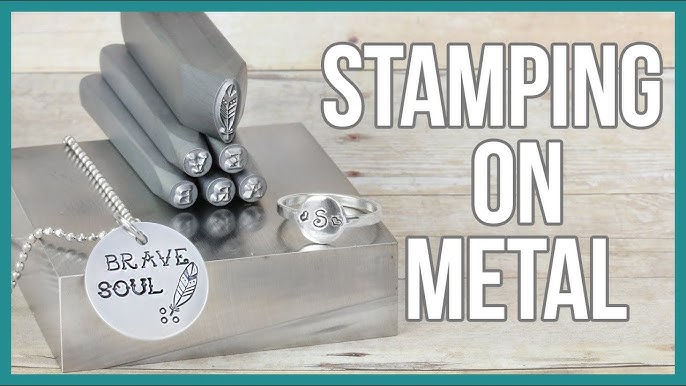Metal Stamping: Everything You Required to Understand About the Process
Metal Stamping: Everything You Required to Understand About the Process
Blog Article
Steel Stamping Technologies: Elevating Production Processes for Superior Results
In the realm of producing procedures, metal marking has actually long been a keystone technique for generating an array of precision components. With the relentless march of technical improvement, the landscape of steel marking is undertaking a substantial improvement.
Advancement of Metal Stamping Methods

Furthermore, improvements in material science have resulted in the growth of high-strength alloys that can currently be perfectly marked right into detailed forms, providing to a wider variety of commercial applications. The combination of robotics and man-made intelligence has actually better maximized the marking procedure by improving speed and precision while lowering the threat of human error.

Effect of Advanced Products
Have innovative products changed steel stamping procedures significantly in the manufacturing sector? By utilizing materials such as high-strength alloys, advanced composites, and cutting-edge finishings, steel stamping procedures can now generate components that are lighter, more powerful, and extra long lasting than ever in the past.
These sophisticated materials use premium mechanical properties, corrosion resistance, and thermal security, allowing manufacturers to meet the demands of modern-day sectors such as aerospace, automotive, and electronic devices. In addition, making use of advanced materials in metal marking has facilitated the manufacturing of complicated geometries and complex designs that were previously unattainable via typical approaches.
Additionally, the application of advanced materials has actually led to reduced material waste, lower production prices, and much shorter lead times, making metal marking procedures a lot more economical and lasting. As innovation continues to breakthrough, the influence of sophisticated materials on metal marking processes is anticipated to drive more development and improve the competition of manufacturers in the international market.
Automation in Steel Stamping
The evolution of metal stamping processes driven by the integration of sophisticated materials has actually set the stage for significant developments in automation within the manufacturing market. Automation in metal marking has transformed manufacturing processes, boosting performance, accuracy, and general output quality. Through the use of robotics, sensors, and computer-controlled systems, tasks that were time-consuming and once hand-operated can currently be performed with unequaled speed and precision.
Automation in metal marking not only increases manufacturing prices yet additionally ensures uniformity in the manufacturing procedure. By decreasing human intervention, the threat of errors is significantly minimized, causing greater degrees of product uniformity and integrity. In addition, automation makes it possible for makers to carry out complex marking jobs that would be tough or unwise to attain by hand.
Additionally, automation in steel marking adds to a much safer working setting by lowering the need for staff members to participate in unsafe or repeated jobs - Metal Stamping. This shift in the direction of automation not just boosts productivity but also leads the way for the future of manufacturing, where innovation plays a central function in driving functional quality
Quality Assurance and Evaluation Solutions
With a concentrate on precision and reliability, high quality control and assessment systems play a crucial duty in making certain item excellence in metal stamping procedures. These systems are made to monitor every phase of production, from product examination to the last product, to guarantee that all parts meet the required standards. By executing advanced modern technologies such as optical inspection systems, coordinate determining equipments (CMM), and automated assessing equipment, suppliers can identify even the smallest variances in dimensions, surface area high quality, and overall stability of stamped parts.

Sustainability Practices in Steel Stamping
Building upon the foundation of accuracy and dependability established via quality control and inspection systems, the assimilation of sustainable techniques in steel marking processes is significantly coming to be a centerpiece for producers seeking to decrease get more ecological influence and optimize source utilization. Sustainability methods in metal stamping incorporate a variety of initiatives focused on reducing waste generation, energy consumption, and greenhouse gas exhausts throughout the production process.
One secret facet of sustainability in steel stamping is the adoption of eco-friendly products and innovations that promote recyclability and waste decrease. By using recycled products and carrying out energy-efficient machinery, makers can reduce their carbon impact and add to an extra lasting production cycle. In addition, optimizing manufacturing processes to decrease material waste and power use not just benefits the atmosphere yet also results in cost financial savings for businesses over time.
In addition, the implementation of lasting methods in steel marking can boost brand online reputation and appeal to ecologically aware customers. As sustainability remains to obtain significance in the production sector, integrating green initiatives right into steel marking procedures is essential for long-lasting success and competition out there.
Verdict
In final thought, metal stamping techniques have actually substantially evolved in time, including sophisticated products and automation to boost producing procedures. Quality assurance and assessment systems play a crucial function in making sure premium results, while sustainability techniques are progressively being applied to reduce environmental impact. These technologies in metal marking have actually revolutionized the market, causing a lot more reliable and sustainable production methods for different industries.
Steel marking, once a handbook and labor-intensive procedure, has transformed into a highly automated and sophisticated method of shaping metal sheets right into different kinds and layouts.Have innovative products transformed metal marking procedures considerably in the manufacturing industry? By making use of materials such as high-strength alloys, advanced compounds, and ingenious finishings, metal stamping procedures can currently produce parts that are description lighter, stronger, and a lot more resilient than ever before.
The evolution of steel marking procedures driven by the assimilation of innovative materials has set the phase for significant improvements in automation within the production sector.In conclusion, metal stamping methods have actually substantially evolved over time, incorporating advanced products and automation to boost manufacturing procedures.
Report this page